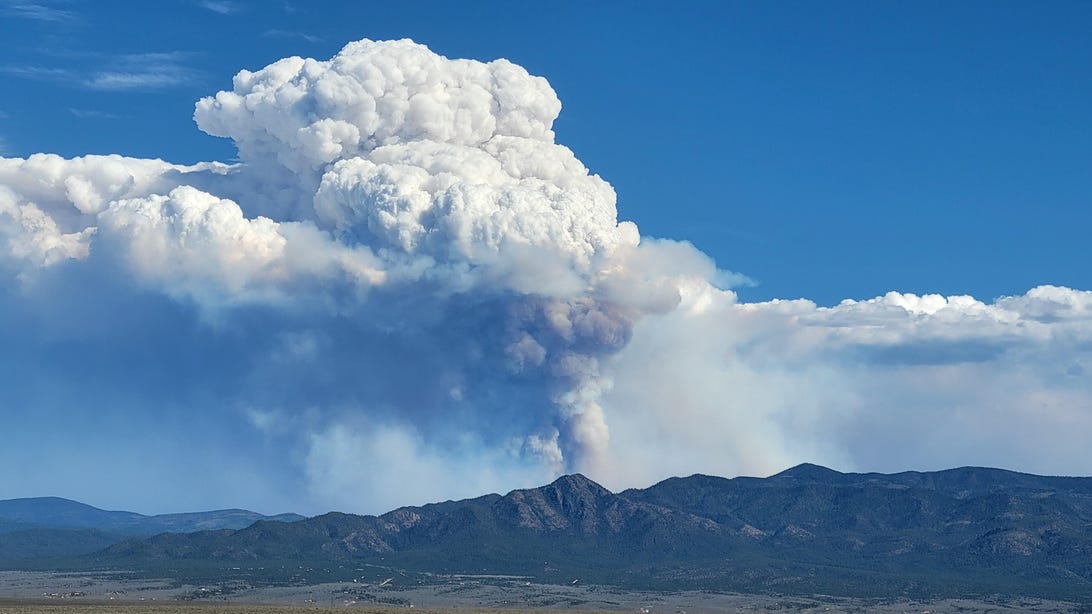Forest Service’s Own Planned Fires Led to Huge New Mexico Wildfire
Forest #Forest

What’s happening
Two fires in New Mexico merged to become the largest in state history. We now know both began with controlled burns.
Why it matters
Over 300,000 acres have burned and continue to burn, impacting tens of thousands of residents.
On Jan. 29, US Forest Service crews completed a pile burn in the Santa Fe National Forest about 17 miles west of the town of Las Vegas, New Mexico. Somewhere in that pile of burnt slash and woody debris, embers would continue to slowly burn for the next nine weeks.
Then, on April 9, a fire sprang back to life from the pile.
Those embers had stayed dormant from the depths of winter until being reawakened in early April. They would go on to grow into the Calf Canyon fire, which would later merge with another wildfire linked to a prescribed burn. The combined Calf Canyon and Hermit’s Peak fire complex has since expanded to over 314,000 acres to become the wildfire with the largest footprint currently burning in the United States, and the biggest in New Mexico history.
As of Friday, the Forest Service, which is part of the federal Department of Agriculture, has now accepted responsibility for both fires that merged into the massive inferno continuing to torch a corridor spanning mountain forests, small villages and over 40 miles.
“Forest Service fire investigators have determined that the Calf Canyon Fire on the Pecos/Las Vegas Ranger District of the Santa Fe National Forest (SFNF) was caused by a pile burn holdover from January that remained dormant under the surface through three winter snow events before reemerging in April,” the agency said in a statement released Friday.
Planned burns — sometimes called controlled or prescribed burns — have been a key part of forest management in the US for years. The basic idea is to reduce the amount of fuel in the forest so that when a fire inevitably does roll through, it’s easier to contain and less likely to lead to a devastating crown fire. Crown fires can happen when abundant fuel load on or close to the ground feeds a fire that burns up to the forest canopy, leading to widespread destruction of the forest and anything else in its path.
“In 99.84 percent of cases, prescribed fires go as planned,” Forest Service Chief Ronald Moore in a statement on May 20.
Under normal conditions, it might be reasonable to assume that a layer of snow already on the ground in January, and the snowstorms that followed, would be sufficient to extinguish any extant hotspots in the burnt pile. But this year, climate change and natural variation in weather patterns have combined to create unusually dry and hot early season conditions across the US Southwest. Weeks of unusually strong winds have exacerbated the situation. At one point in early May, the National Weather Service had issued a red flag warning — meaning wind, heat and dryness creating ideal conditions for wildfire ignition and spread — for northern New Mexico on 25 of the previous 30 days.
The fire has forced tens of thousands of New Mexicans from their homes for several weeks, hundreds of homes and other structures have been destroyed, livestock have been lost. Fortunately, there have been no human casualties.

Smoke from the fire, as seen from Taos, New Mexico, on May 15.
Eric Mack/CNET
New Mexico Gov. Michelle Lujan Grisham welcomed the announcement that the Forest Service was assuming responsibility, but did not mince words.
“The pain and suffering of New Mexicans caused by the actions of the U.S. Forest Service – an agency that is intended to be a steward of our lands – is unfathomable,” she said in a statement Friday. “This is a first step toward the federal government taking full responsibility.”
After the Calf Canyon fire first reemerged from that winter pile burn on April 9, it burned an acre and a half before firefighting crews were able to build a containment line around the blaze.
Ten days later, the fire again sprang to life with the help of strong winds and extreme fire conditions. It escaped the containment lines on April 19 and then grew significantly as gusty winds fed the fire on April 22.
By the first week of May, the Calf Canyon blaze grew to merge with the Hermit’s Peak fire, which itself was caused by a prescribed burn also set by the US Forest Service.
On April 6, the agency began that burn several miles to the north of where the Calf Canyon pile burn was still secretly smoldering.
“Although forecasted weather conditions were within parameters for the prescribed fire, unexpected erratic winds in the late afternoon caused multiple spot fires that spread outside the project boundary,” said the Forest Service summary of the incident. “It was declared a wildfire at approximately 4:30 p.m. on April 6, 2022.”
Lujan Grisham began calling for a temporary halt to prescribed burns in the state after the fires merged, and the Forest Service eventually agreed.
“I am initiating a pause on prescribed fire operations on National Forest System lands while we conduct a 90-day review of protocols, decision support tools and practices,” said Moore, the Forest Service chief.
On Friday, Lujan Grisham insisted that the federal government reevaluate its fire management practices to account for climate change that has contributed to a historic megadrought in the Southwest.
“New Mexico and the West must take every precaution to prevent fires of this magnitude from occurring, especially as precipitation levels continue to decrease and temperatures rise.”
The combined fire is now 50% contained, with over 3,000 firefighting personnel working to increase that figure while also bracing for a forecast that portends more heat, wind and critical fire weather conditions.